What is Wind & Who Measures it? for Under Fives
This page is the one which is best used first in the work on windy weather. A full introduction to the work can be found on the Windy Weather page. There is a fuller list of resources on that page, and some more hints on necessary preparation.
This section deals with what wind is, and who measures it. You may like to also make a Wind Measurer and have fun with Windy Words and Actions.
Resources (also linked on the right)
- These Windy Weather pages in summary Word format for easy printing.
- Windows Media files; What is the wind? Click on the link and the video should open up in a new window..

- Wind Vocabulary signs
- Wind recording sheet
- Resources about amateur weather recording of wind measurements (photographs and videos linked on the right)
- Wind Map UK – flash file, double click to run. You may need to allow ActiveX if a message pops up.
- Map Wind Arrows sheet – cut out the arrows and laminate them for use on a large map
- Cockerel video and photograph - he crows wonderfully!
- Outline cockerel picture to print and decorate
- Cockerel image to load into a paint package and fill with the fill tool (png image)
- Making a paper windmill - list of URLs and hints on how to put together and activity. This is intended as an activity for student teachers, but will hopefully be useful for others as well.
- Website URLs
Resources you might like to acquire
- Weather vane (it would be nice if every school had one on the roof). A weather vane (perhaps plastic) to look at close-up is also useful. It can be mounted on a block of wood so that it stands up.
- kite, umbrella, wind chime, weather vane, large feathers, hats, hand fans – all good for the display
- items to test to see if the wind blows them - feathers, leaves, tissue, conker, acorn, penny, dandelion seeds, sycamore seeds (remind the children that they should not eat any of the seeds)
- an electric fan for use under supervision when the weather does not oblige
- a basic anemometer – something which visually shows the wind speed. Some examples can be seen on the wind pages. A video clip of a good example for younger weather observers is on the More About Wind Measurements page
(http://www.weatherforschools.me.uk/html/morewind.html ). - Compass Rose, correctly orientated and painted on the playground.
Preparation
- Gather together some resources to support the work. Items could include; kite, umbrella, wind chime, weather vane, large feathers, hats, hand fans, electric fan
- Check that the What is the Wind video runs OK. Click on the link and it should open in a new window. You can also see it on You Tube.
- Select some small items to be tested to see if they get blown by the wind. This could include some heavier items. Suggestions; feathers, leaves, tissue, conker, acorn, penny.
- Print out some pictures of windy weather. Putting windy weather into Google Images brings up some super ones. Avoid any that might be frightening, bad storms are perhaps not appropriate.
- Check to see how you can best run the Wind Map UK flash file. You can run it in Windows Explorer using ‘file’ and ‘open’ or put it into an IWB file. You can just double click and see what happens on your PC. You may need to enable ActiveX if a message prompts you to do so. If you would like a version with a different county’s map, email us and we’ll see if we can find a free map of your country. We’ll then do a version just for you.
- Locate a large map of your country, perhaps a cloth one, print out and laminate the set of arrows (see Wind Arrows Sheet jpg provided)
- Enlarge the cockerel outline picture to A3 to make it better for display and for little fingers to stick things on, finger paint etc..
- Save the cockerel picture to fill image into an appropriate place for the children to access. Right click on the link and save it in the desired location. You may want to rename it and back it up.
What is wind?
Large group - Look at examples of what wind does
Show the video What is the Wind? An IWB and sound will make the experience more meaningful.
Allow plenty of time for discussion. Pause if necessary to allow discussion. If possible relate to what is happening outside, recent weather, items on display.
Small group/individual - What gets blown by the wind?
Set up an activity for the children to find out what gets blown by the wind. If possible make this an outdoor activity. If not, set up a fan for the children to use. Provide a selection of objects to drop and to see if they go straight down or if they get blown a little way as they fall. Use two containers to sort the items into.
Who Measures the Wind?
Weather forecasts
Take a little look at a weather forecast. See a national one at http://news.bbc.co.uk/weather/forecast/10 You can switch to a local one, and make it full screen. There are wind arrows on this as well, you might want to come back to the forecast when you look at wind strength. Ask the children how the weather man knows what the wind is like round the country. Explain that people (and automatic equipment – but this is a bit complicated) are taking readings all over the country.
Large group - Look at the amateur weather enthusiast photographs.
- There is a man recording the wind direction from a weathervane. The initials of the points of the compass can be seen. The arrow points to where the wind is coming from. In the reflection you can see that he has a sheet to record his data on. The video clip shows the pointer on a weather vane moving. You have to decide which way it is pointing most.
- There is a photograph and a video clip of a man measuring the wind strength (speed) with a basic anemometer. The cups can be seen spinning round. The faster they go, the stronger the wind.
 |
 |
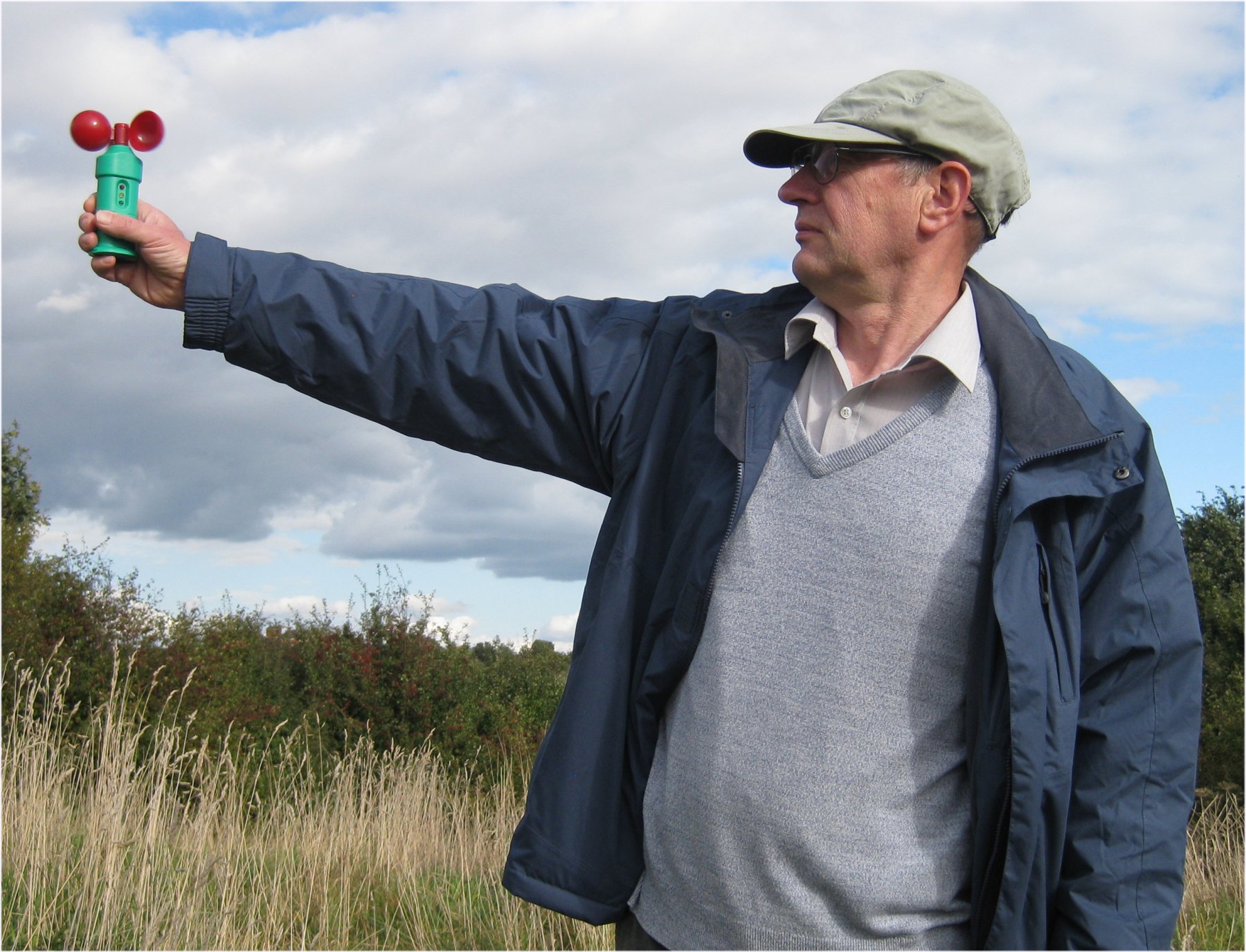 |
Look at the reflection in this image. What can you see? |
Video |
Video |
Discuss what is being done and why. Explain that people want to know what the weather has been like, and what it will be like. They might need to know so that they can look after their property, garden or animals.
Wind direction
Large or small group - Observing the wind
Take the children to stand outside on a windy day. Ask them to turn round until they can feel the wind on their faces. That is where the wind is coming from. Let them point in that direction. On another day repeat and hope that the wind is from a different direction. On both days look at the weather vane on the roof. The pointer is pointing to where the wind is coming from. Is it the same direction that they pointed in. (It could be different if the wind is being channeled round buildings etc.. Also it may look like a slightly different direction if the two locations are a fair distance apart. As the key learning point is that the wind comes from somewhere, this should not be a cause for concern.)
Large group - Looking at different weather vanes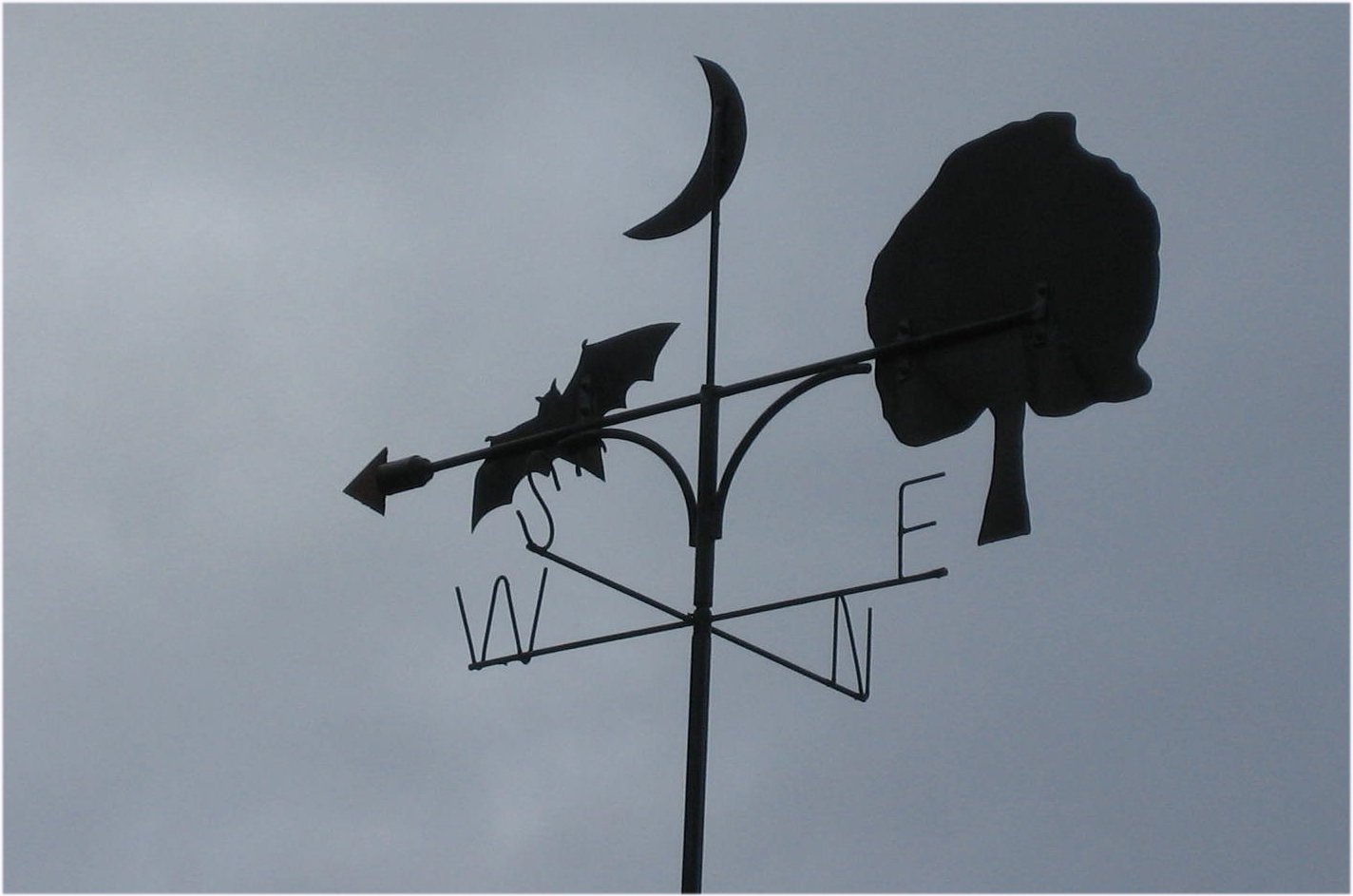
You could start by looking at the pages about the Cockerel Weather Vane on top of the church. There may be some real ones in the area nearby that you could look at. Look at photographs as well. A cheap plastic one can be bought into the classroom, so that the children can spin it. Look at some images of traditional cockerel weather vanes. Look at some pictures of real cockerels with their colourful feathers. The weather vanes point to where the wind is coming from. We can then decide if it is bringing warm or cold weather, and if it will bring wet or dry weather. The photograph on the right shows the weather vane at a nature centre. You could ask the children why it has a bat and a tree on it.
Small group / individual - Decorating a cockerel to be a pretend weather vane
Use the outline drawing of a cockerel or one you have prepared yourself. Make it look like a weather vane cockerel by drawing the downward part that joins it to the weather vane. Print it out on paper of various colours to show in the parts which do not get decorated. Let the children use whatever materials you suggest to colour in the cockerel. They could finger paint, paint, apply real feathers, stick on paper feathers which have been cut out and curled or any other decorative technique. When you cut them out and put them on a sky and roof background you can add a ‘N’ and a ‘S’ for north and south or even do a 3D bit with three of the points of the compass.
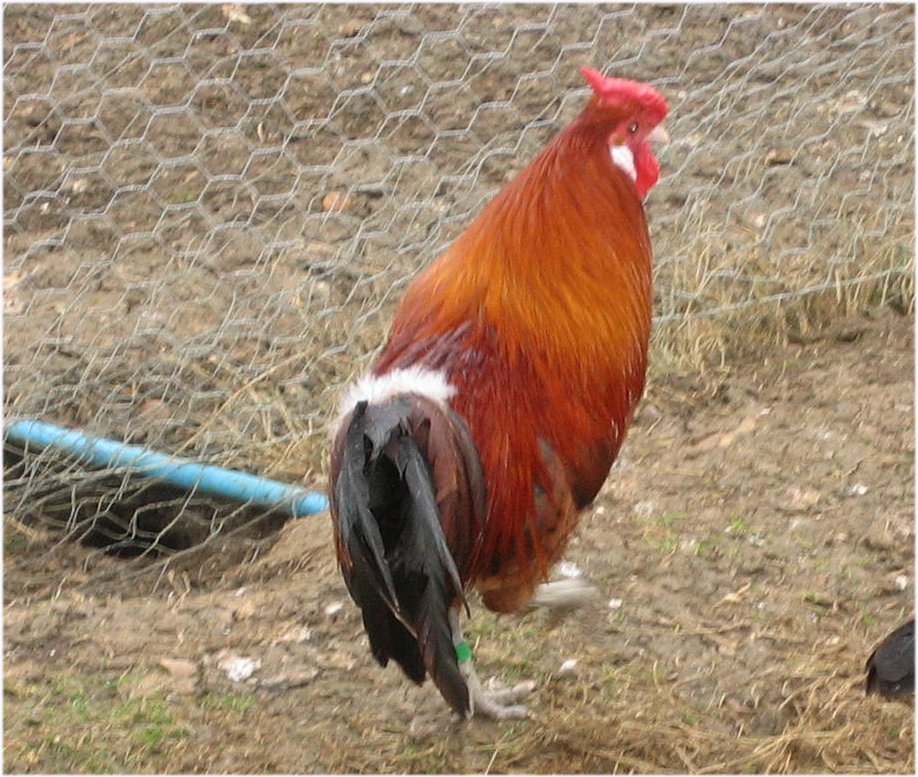 |
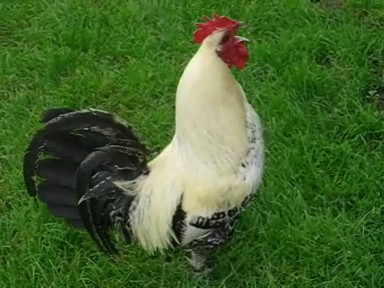 |
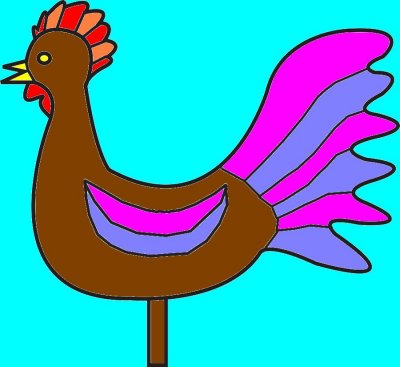 |
| A colourful cockerel | Click here to see and hear this cockerel crowing. | A cockerel filled with the fill tool in Paint |
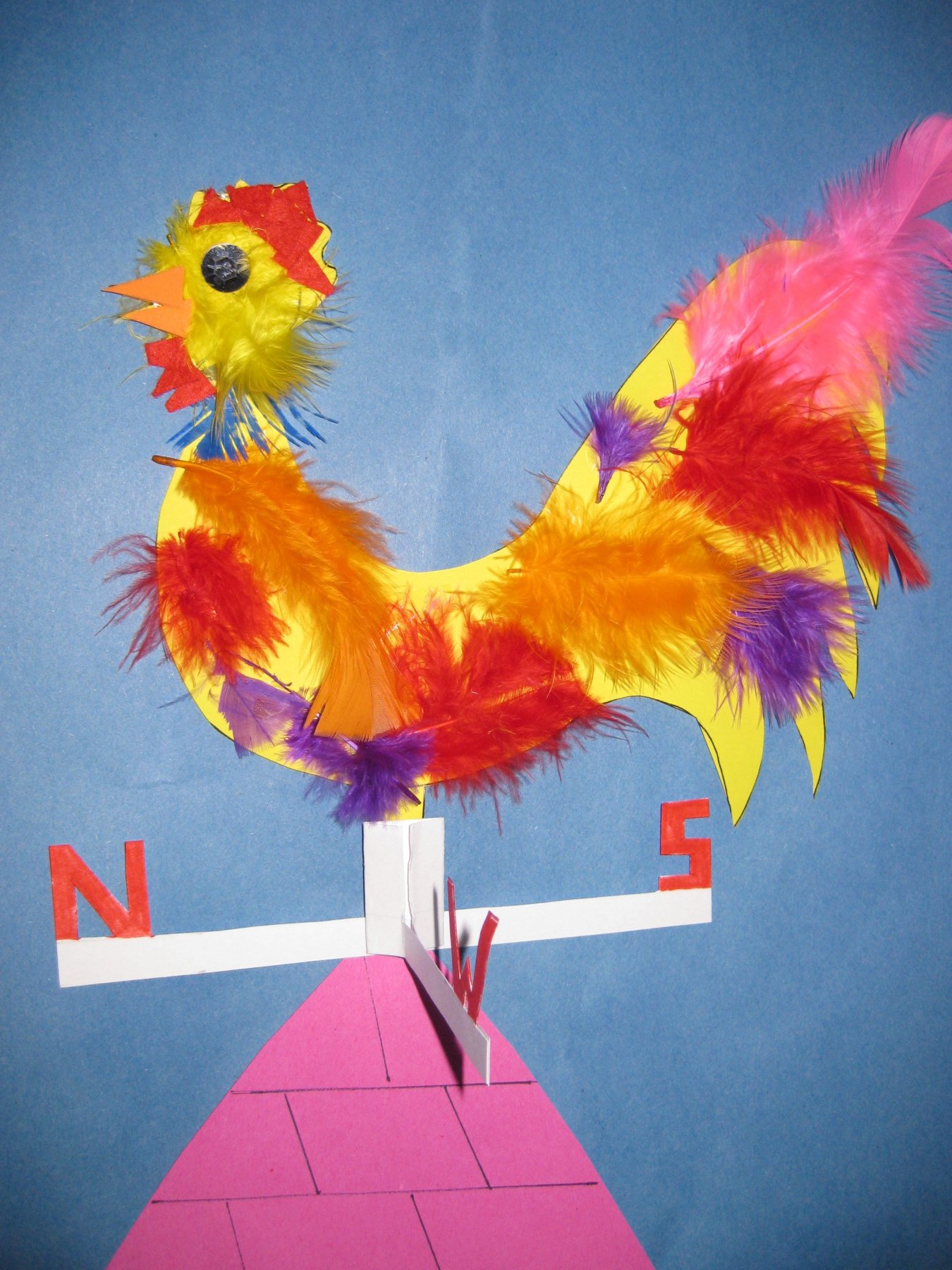 |
 |
 |
Click on the picture to see it bigger. The 'west' pointer is 3D. |
This ornamental cockerel is made of metal. He 'lives' in the garden. |
The fill tool for the activity below. |
Small group / individual – Using the fill tool in a paint package to colour a weather vane cockerel
Use the png cockerel image, as this allows easy filling of the different parts of the cockerel. If the children have not used the fill tool before, model how to select the fill tool, choose a colour, and click on the section to fill. You will need to use your usual system for printing and/or saving the images. The image above is a filled example of the image. There is also a fill icon from the Paint package. This is the tool you will need for filling.
Wind strength
Large group - What are wind arrows?
Look at the website below to prompt discussion. Some pointers are included.
XC Weather
http://www.xcweather.co.uk/
Look at this wind map. Some examples to prompt discussion are included below.
- Have you see a map like this before? This is the United Kingdom.
- Can you see some big arrows? The big arrows show us where it is going to be very windy. The wind will be very strong there. The leaves will get blown around a lot.
- Can you see some little arrows? It is not very windy there. You would not be able to fly your kite there.
- The arrows are not all pointing the same way. They are pointing to where the wind is going. We can see where the wind is coming from.
(Important point – the pointer on a wind vane points to where the wind is coming from.)
Large group - Using Wind Arrows
Use the Wind Map UK file on an IWB. Remind the children of what the map represents. Discuss the difference between land and sea. Move a dot to your location. Is it near t he sea or in the middle of the land? Is it in the north or the south? Look outside to see how windy it is. Ask the children what arrows they think are best for the weather today. Drag arrows of the appropriate size and place them around the area of the dot. Don’t worry if they cover most of the country! To change the direction of the arrows use the right and left cursor keys. You can use the snapshot feature of the IWB software, or simple press print screen and paste it into a paint package or a word document to save. This way you will be able to print out a record of the wind each day and display it.
he sea or in the middle of the land? Is it in the north or the south? Look outside to see how windy it is. Ask the children what arrows they think are best for the weather today. Drag arrows of the appropriate size and place them around the area of the dot. Don’t worry if they cover most of the country! To change the direction of the arrows use the right and left cursor keys. You can use the snapshot feature of the IWB software, or simple press print screen and paste it into a paint package or a word document to save. This way you will be able to print out a record of the wind each day and display it.
AND / OR
Prepare the wind arrows by printing out the map wind arrows sheet, cutting out the arrows and laminating them. Put up a large map of the country.
Look at the large map of your country. Put the laminated dot on your location. Is it near the sea or in the middle of the land? Is it in the north or the south? Look outside to see how windy it is. Ask the children what arrows they think are best for the weather today. Fix a few arrows of the right size onto the map near the marker dot. Return to the map each day and see if the arrows need changing. Don’t worry about the direction, unless you feel there are some children ready to hear about the four points of the compass. However do make sure that there is a compass rose on the map. The advantage of this version of the activity is that it can be left out for the children to use independently.
The Full List of Activities
What is wind?
Who Measures the Wind?
Making a wind measurer
Songs about the wind
Wind Poetry
Wind Story
